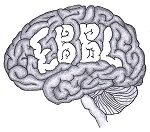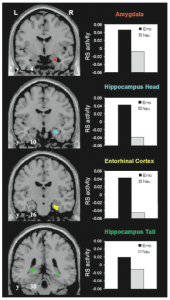In my previous blog posts, I have discussed role emotion as it relates to memory consolidation processes. However, equally important is the process of memory retrieval. With regard to the definition of memory retrieval as it is relevant in this blog post, I refer specifically to neural processes and activation at the time of recall or recognition of previously-presented stimuli. Memory retrieval processes are distinct from the consolidation processes I have discussed previously, which refer to processes occurring at the time when stimuli are originally presented and memories are formed. While fewer studies have examined neural activation associated with emotional memory retrieval than activation associated with emotional memory consolidation, there is some evidence supporting distinct activation associated with retrieval processes. I will first discuss the neural evidence associated with emotional memory consolidation and then discuss the role of context in memory retrieval as it relates to emotion.
Research has found that there appears to be some differential activation between memory retrieval of emotional vs. neutral information, although some obstacles have emerged that complicates the issue. One problem that researchers face in studying emotional memory retrieval is distinguishing retrieval from other memory processes like consolidation. Some studies have used very short intervals—sometimes only a matter of minutes—between stimuli presentation (when memory consolidation processes occur) and subsequent memory tests (when retrieval occurs) (Dolcos, 2004). It can be argued that this does not allow enough time to distinguish neural activation associated with consolidation and retrieval processes, thus necessitating larger retention intervals (time between presentation of stimuli to be remembered and time when memory for stimuli is tested).
In light of this, Dolcos et al. (2004) measured the neural activity associated with retrieval of emotional and neutral pictures after a retention interval of 1 year. fMRI results showed that emotionally-salient pictures, as compared to neutral pictures, led to increased activation in the amygdala, as well as the hippocampus head, entorhinal cortex, and hippocampus tail (Figure 1). Furthermore, not only do these structures show greater absolute activation in emotional vs. neutral memory retrieval, but they show great coactivation as well (Ritchey et al., 2008) (Dolcos et al., 2004). This is in line with research conducted by St. Jacques et al. (2011) and others into coactivation of the amygdala and neural memory regions in individuals with post-traumatic stress disorder. In PTSD individuals, for example, emotional cues may trigger recollection of traumatic memories, activating hippocampal regions and increasing fear-related activation of the amygdala simultaneously.
One important question that researchers have tried to answer within the realm of emotional memory retrieval is whether observed differences in neural activation are due to the emotionally-toned context the stimuli are presented in rather the inherent emotional nature of the stimuli. In short, how important is context—the circumstances or setting in which the critical stimulus is presented—in retrieval of emotional memories? In one experiment, Maratos & Rugg (2001) analyzed participants’ memory and associated electrophysiological activation (by means of an EEG) of neutral words that had presented in either neutral or negative sentences. These sentences provided the “emotional context” for each word that was presented. The researchers found that retrieval of words in negative sentences, as compared to neutral sentences, was associated with great electrophysiological activation of left parietal and right frontal regions. However, in a subsequent experiment in the same study, the researchers found that when participants were asked to indicate and recall whether each word had been presented in either a negative or neutral sentence (i.e. context), the left parietal and right frontal activation were equal for negative and neutral contexts. This suggests that when contextual retrieval is intentional, people may rely on the same neural pathways for both emotionally-salient and neutral memories.
Several fMRI studies have allowed for more specific neural activation results in examining the role of context in emotional memory retrieval. Two studies have specifically examined the role of context in emotional memory by looking at positive, negative, and neutral emotional contexts (Maratos et al., 2001), (Smith et al. 2004). Both studies found greater activation of the amygdala during emotional memory retrieval than neutral memory retrieval, regardless of whether the sentence was positively or negatively valenced. As I wrote in my first blog post, which discussed arousal-mediated memory consolidation, much research supports the amygdala playing an important, arousal-dependent role in the consolidation of emotional memories.
Together, these findings suggest that the amygdala is an important region in multiple, distinct emotional memory processes (both consolidation and retrieval). Other brain regions that show greater activation regardless of the valence of the context in which they are presented include the anterior cingulate, insula, and orbitofrontal cortex (Figure 2). Studies have shown that the insula is activated when viewing both negative and positive pictures, while the anterior cingulate has been shown to play a role in valence-independent aspects of autonomic control and problem solving (Smith et al., 2004), which may explain these findings.
As I have discussed, research shows emotional memory retrieval is associated with relatively greater activation of the amygdala and medial temporal lobe structures like the hippocampus and entorhinal cortex. Additionally, the context in which a stimuli is presented, rather than the solely stimuli—appears to be an important determinant of neural activation. More research into the neural basis of emotional memory retrieval is certainly warranted. In addition, from a clinical perspective, having a more holistic understanding the neural activation associated distinctly with emotional vs. neutral memory retrieval may lead to better treatment options for individuals with PTSD, who suffer psychologically and physically from the consequences of retrieval of certain highly affective memories.
CITATIONS:
Dolcos, F. LaBar, K. S., Cabeza, R. (2004). Remembering one year later: Role of the amygdala and the medial temporal lobe memory system in retrieving emotional memories. Proceedings of the National Academy of the Sciences, 102(7), 2626-2631.
Maratos, E.J., Dolan, Morris, J.S., Henson, R.N.A., Rugg, M. D. (2001). Neural activity associated with episodic memory for emotional context. Neuropsychologia, 39, 910-920.
Maratos, E. J., Rugg, M. D. (2001). Electrophysiological Correlates of the Retrieval of Emotional and Non-emotional Context. Journal of Cognitive Neuroscience, 13(7), 877-891.
Ritchey, M., Dolcos, F., Cabeza, R. (2008). Role of Amygdala Connectivity in the Persistence of Emotional Memories Over Time: An Event-Related fMRI Investigation. Cerebral Cortex, 18(11), 2494-2504.
Smith, A.P.R., Henson, R.N.A., Dolan, R.J., Rugg, M.D. (2004). fMRI correlates of the episodic retrieval of emotional contexts. NeuroImage, 22, 868-878.
St. Jacques, P. L., Botzung, A., Miles, A., Rubin, D. C. (2011). Functional Neuroimaging of Emotionally Intense Autobiographical Memories in Post-Traumatic Stress Disorder. Journal of Psychiatric Research, 45(5), 630-637.


